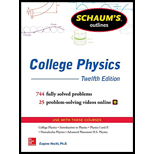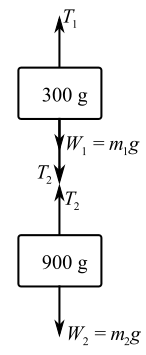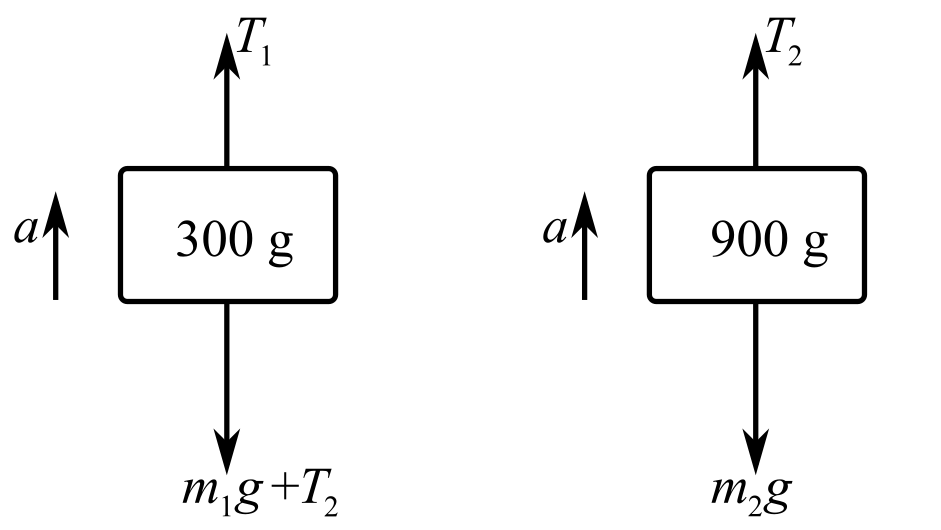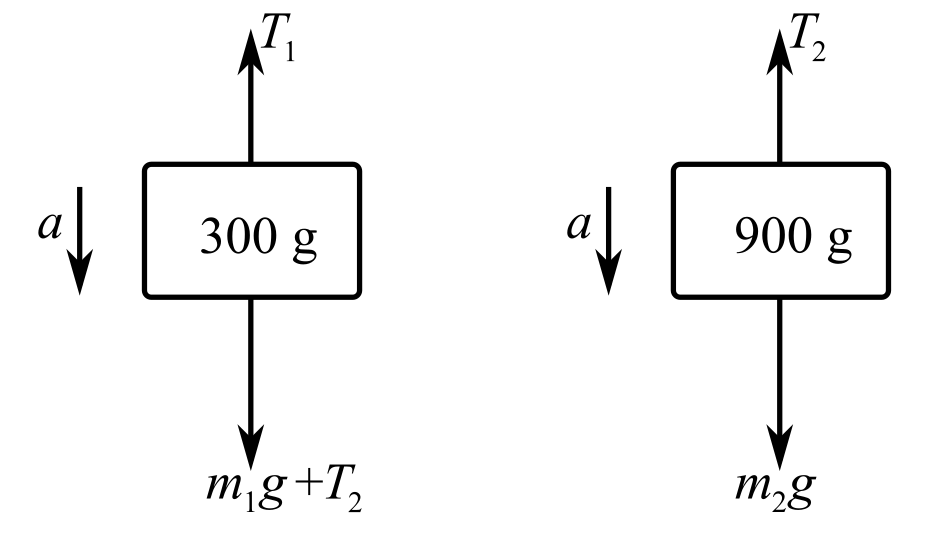
Concept explainers
A 300-g mass hangs at the end of a string. A second string hangs from the bottom of
that mass and supports a 900-g mass. (a) Find the tension in each string when the
masses are accelerating upward at
tension in each string when the acceleration is
(a)
The tension in eachstring when the masses are accelerating in upward direction at
Answer to Problem 64SP
Solution:
Explanation of Solution
Given data:
The mass of the block that is hanging on the first string is
The mass of the block that is hanging on the second string is
Upward acceleration of the masses is
Formula used:
From the Newton’s second law of the motion, the expression of the force is
Here,
Explanation:
Draw the free body diagram of the system by analyzing the problem:

In the above diagram,
Draw the free body diagram of the masses separately when acceleration is in upward direction:

Consider free body diagram of the
Consider the direction of the upward forces as positive and the direction of the downward forces as negative. Therefore,
Here,
Substitute
Solve the above equation for
Consider free body diagram of the
Consider the direction of the upward forces is positive and the direction of the downward forces is negative. Therefore,
Substitute
Solve the above equation for
Conclusion:
Therefore, the value of the tension in the strings by which
(b)
The tension in each string when the masses are accelerating in the downward direction at
Answer to Problem 64SP
Solution:
Explanation of Solution
Given data:
The mass of the block that is hanging on the first string is
The mass of the block that is hangingon the second string is
Downward acceleration of the masses is
Formula used:
From the Newton’s second law of the motion, the expression of the force is
Here,
Explanation:
Draw the free body diagram of the each masses separately when acceleration is in downward direction:

Consider the free body diagram of the
Consider the direction of the upward forces as positive and the direction of the downward forces as negative. Therefore,
Substitute
Solve the above equation for
Consider the free body diagram of the
Consider the direction of the upward forces is positive and the direction of the downward forces is negative. Therefore,
Substitute
Solve the above equation for
Conclusion:
Therefore, the value of the tension in the strings by which the
Want to see more full solutions like this?
Chapter 3 Solutions
Schaum's Outline of College Physics, Twelfth Edition (Schaum's Outlines)
- What is the force (in N) on the 2.0 μC charge placed at the center of the square shown below? (Express your answer in vector form.) 5.0 με 4.0 με 2.0 με + 1.0 m 1.0 m -40 με 2.0 μCarrow_forwardWhat is the force (in N) on the 5.4 µC charge shown below? (Express your answer in vector form.) −3.1 µC5.4 µC9.2 µC6.4 µCarrow_forwardAn ideal gas in a sealed container starts out at a pressure of 8900 N/m2 and a volume of 5.7 m3. If the gas expands to a volume of 6.3 m3 while the pressure is held constant (still at 8900 N/m2), how much work is done by the gas? Give your answer as the number of Joules.arrow_forward
- The outside temperature is 25 °C. A heat engine operates in the environment (Tc = 25 °C) at 50% efficiency. How hot does it need to get the high temperature up to in Celsius?arrow_forwardGas is compressed in a cylinder creating 31 Joules of work on the gas during the isothermal process. How much heat flows from the gas into the cylinder in Joules?arrow_forwardThe heat engine gives 1100 Joules of energy of high temperature from the burning gasoline by exhausting 750 Joules to low-temperature . What is the efficiency of this heat engine in a percentage?arrow_forward
- L₁ D₁ L₂ D2 Aluminum has a resistivity of p = 2.65 × 10 8 2. m. An aluminum wire is L = 2.00 m long and has a circular cross section that is not constant. The diameter of the wire is D₁ = 0.17 mm for a length of L₁ = 0.500 m and a diameter of D2 = 0.24 mm for the rest of the length. a) What is the resistance of this wire? R = Hint A potential difference of AV = 1.40 V is applied across the wire. b) What is the magnitude of the current density in the thin part of the wire? Hint J1 = c) What is the magnitude of the current density in the thick part of the wire? J₂ = d) What is the magnitude of the electric field in the thin part of the wire? E1 = Hint e) What is the magnitude of the electric field in the thick part of the wire? E2 =arrow_forwardplease helparrow_forwardA cheetah spots a gazelle in the distance and begins to sprint from rest, accelerating uniformly at a rate of 8.00 m/s^2 for 5 seconds. After 5 seconds, the cheetah sees that the gazelle has escaped to safety, so it begins to decelerate uniformly at 6.00 m/s^2 until it comes to a stop.arrow_forward
- A projectile is fired with an initial speed of 40.2 m/s at an angle of 35.0 degree above the horizontal on a long flat firing range. Determine. please help and show work for them so i can understand.arrow_forwardpls helparrow_forwardJ K L The graph in the figure shows the position of an object as a function of time. The letters H-L represent particular moments of time. At which moments shown (H, I, etc.) is the speed of the object the greatest? + Position H I K Timearrow_forward
 University Physics Volume 1PhysicsISBN:9781938168277Author:William Moebs, Samuel J. Ling, Jeff SannyPublisher:OpenStax - Rice University
University Physics Volume 1PhysicsISBN:9781938168277Author:William Moebs, Samuel J. Ling, Jeff SannyPublisher:OpenStax - Rice University Physics for Scientists and Engineers: Foundations...PhysicsISBN:9781133939146Author:Katz, Debora M.Publisher:Cengage Learning
Physics for Scientists and Engineers: Foundations...PhysicsISBN:9781133939146Author:Katz, Debora M.Publisher:Cengage Learning Physics for Scientists and Engineers with Modern ...PhysicsISBN:9781337553292Author:Raymond A. Serway, John W. JewettPublisher:Cengage Learning
Physics for Scientists and Engineers with Modern ...PhysicsISBN:9781337553292Author:Raymond A. Serway, John W. JewettPublisher:Cengage Learning Physics for Scientists and EngineersPhysicsISBN:9781337553278Author:Raymond A. Serway, John W. JewettPublisher:Cengage Learning
Physics for Scientists and EngineersPhysicsISBN:9781337553278Author:Raymond A. Serway, John W. JewettPublisher:Cengage Learning Principles of Physics: A Calculus-Based TextPhysicsISBN:9781133104261Author:Raymond A. Serway, John W. JewettPublisher:Cengage Learning
Principles of Physics: A Calculus-Based TextPhysicsISBN:9781133104261Author:Raymond A. Serway, John W. JewettPublisher:Cengage Learning College PhysicsPhysicsISBN:9781285737027Author:Raymond A. Serway, Chris VuillePublisher:Cengage Learning
College PhysicsPhysicsISBN:9781285737027Author:Raymond A. Serway, Chris VuillePublisher:Cengage Learning





